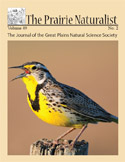Great Plains Natural Science Society
Date of this Version
12-2015
Document Type
Article
Citation
The Prairie Naturalist 47: 119.; 2015
Abstract
Many readers of The Prairie Naturalist have lived along or visited Lake Superior’s coast. Like me, you have probably wondered about the geology and history of this beautiful and dramatic feature of northeastern Minnesota. Chel Anderson and Adelheid Fischer have written an accessible book that comprehensively describes the history and geology of the coast, surrounding highlands, and Lake Superior itself. In addition, the authors have provided fascinating subchapters on some of the most interesting species that are key elements of the region.
This rather large but beautiful book is arranged in five major chapters that cover the dominant geological units of the North Shore: Headwaters, Highlands, Nearshore, Lake Superior, and Islands. This is a natural division that allows for a coherent description of the unique geological, floristic, and anthropogenic characters of each important ecosystem. Each chapter begins with an overview of the geology that fashions the ecosystems. The Headwaters chapter, for instance, moves from the glacial history to the interplay of land and water that shaped the dry forests, headwater streams, lakes, and wetlands, with special attention to the role that the American beaver (Castor canadensis) played in shaping the headwater ecosystems. Lake Superior is described in the context of the multiple glacial advances and retreats and the Midcontinent Rift System that developed into this highly variable and largest lake in North America. The narrative summarizes considerable technical information but at a level that is accessible to both experts and laypersons.
Included in
Biodiversity Commons, Botany Commons, Ecology and Evolutionary Biology Commons, Natural Resources and Conservation Commons, Systems Biology Commons, Weed Science Commons


Comments
Published by the Great Plains Natural Science Society. Used by permission.